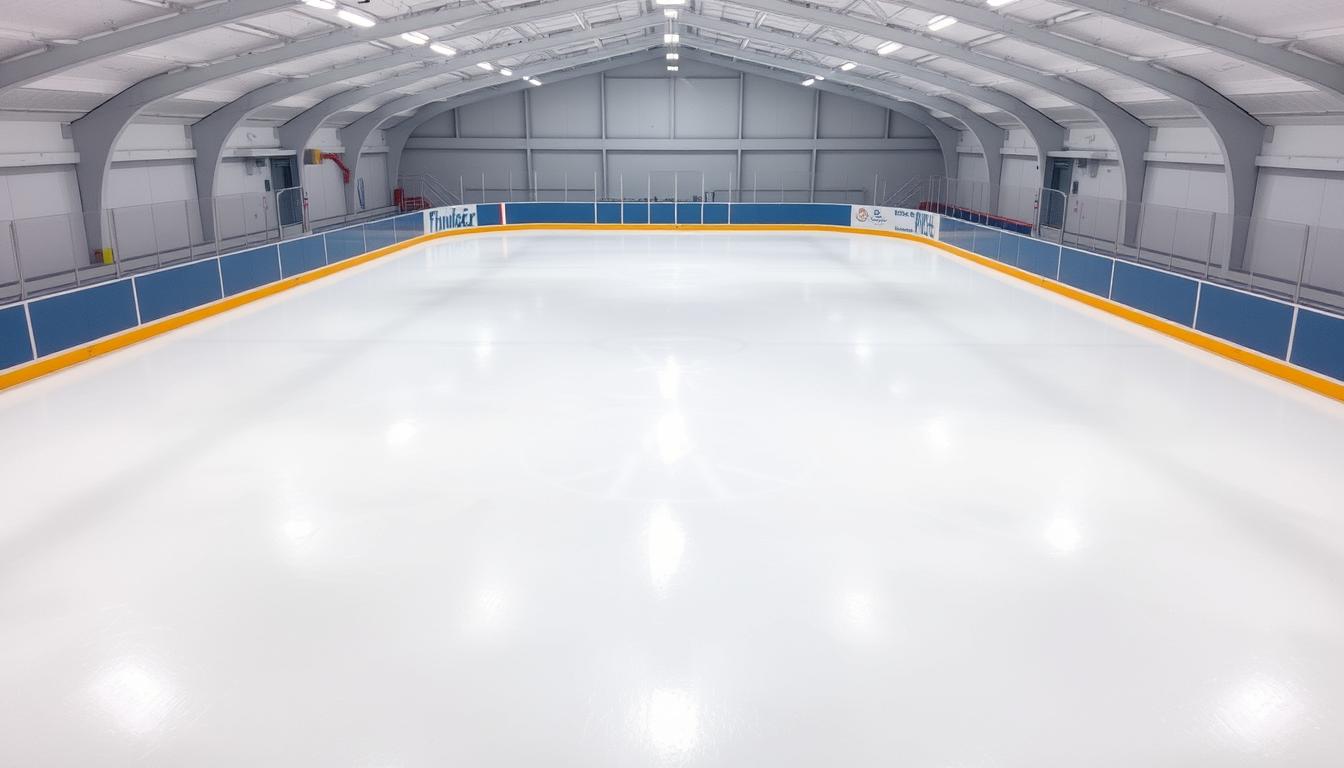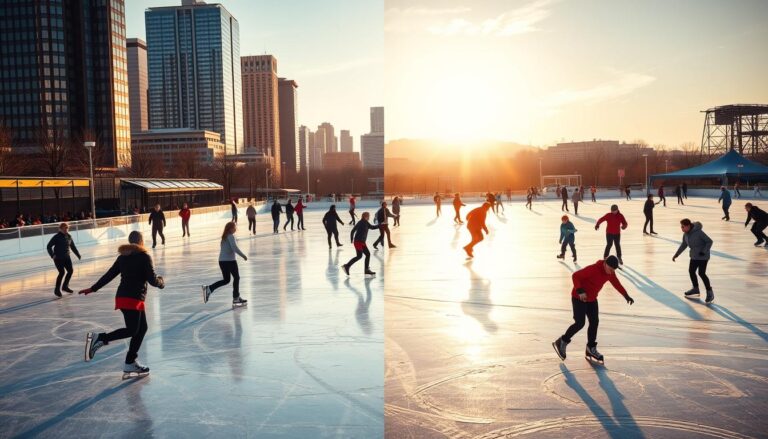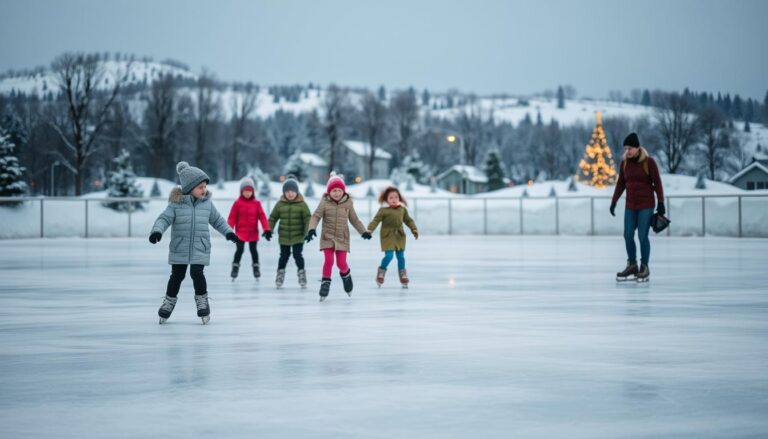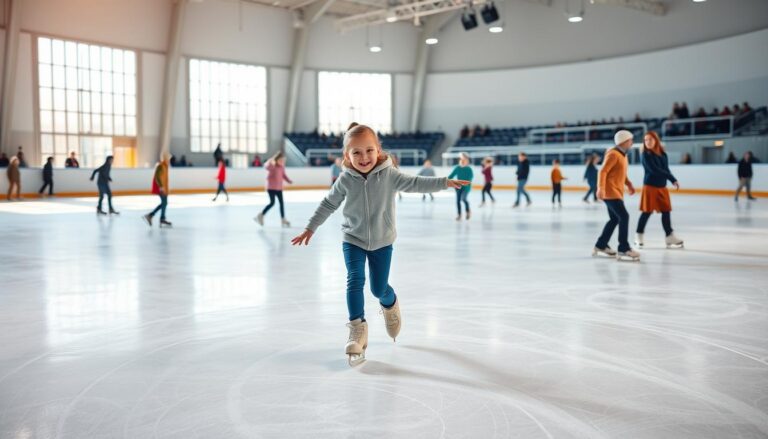Synthetic Ice Skating: An Affordable Alternative to Traditional Ice
Imagine turning any space into a skating paradise without the hassle of traditional ice rinks. Synthetic ice skating is a game-changer for athletes, enthusiasts, and casual skaters. It offers flexibility and convenience, making skating possible in places once thought impossible.
So, what is synthetic ice skating? It’s a surface that feels like real ice but doesn’t need cold temperatures or constant upkeep. It’s a flexible alternative that opens up ice sports to more people.
Both pros and hobbyists are finding synthetic ice skating amazing. These panels provide a smooth skating experience that can be set up at home, in training centers, or commercial areas. The tech has improved a lot, making it as good as real ice.
Skaters of all levels can benefit from synthetic ice. It lets you keep practicing all year, no matter the weather or where you are. It’s great for both newbies and experts.
Synthetic ice rinks are more than just tech. They make ice sports more accessible and affordable. They’re perfect for setting up a home practice area or a professional training space. This flexibility is unmatched.
Exploring synthetic ice skating opens up a world of possibilities. This guide will show you the tech, benefits, and uses that are changing ice sports forever.
Understanding the Basics of Synthetic Ice
Synthetic ice technology has changed how we skate. It lets us glide on surfaces that can’t hold real ice. This makes skating fun in places where ice rinks can’t go.
Skating fans love synthetic ice for its amazing performance and flexibility. It’s changing how we enjoy winter sports and fun activities.
Chemical Composition and Materials
Synthetic ice is made from special polymers. These materials help you skate smoothly. The main parts are:
- High-density polyethylene (HDPE)
- Ultra-molecular weight polymers
- Self-lubricating composite materials
Core Technology Behind Synthetic Surfaces
What makes synthetic ice special is its engineering. It’s designed to feel like real ice. Scientists have created panels with special molecules that:
- Make sliding easier
- Ensure a smooth glide
- Last long even when used a lot
Development and Evolution
Synthetic ice has come a long way. The first versions had too much friction. But now, thanks to new tech, it’s much better.
| Generation | Key Characteristics | Performance Rating |
|---|---|---|
| First Generation | High friction, limited glide | 2/10 |
| Current Generation | Low friction, near-ice experience | 8/10 |
Today, synthetic ice is a big win in materials science. It gives skaters a great option instead of real ice.
What is Synthetic Ice Skating: A Comprehensive Guide
Synthetic ice skating is a new way to enjoy ice sports without frozen water. It lets skaters glide and train like on real ice but with cool tech perks.
This method uses special polymer panels that feel like natural ice. Skaters can try out moves and skate freely, no matter the weather.
- Engineered from high-performance polymers
- Provides consistent skating surface
- Usable in various temperature conditions
- Minimal maintenance requirements
The surface is made with advanced materials for less friction and a real ice feel. You can use your usual ice skates, making it easy to switch between synthetic and real ice.
| Feature | Synthetic Ice | Traditional Ice |
|---|---|---|
| Temperature Dependency | Independent | Requires Freezing |
| Installation Cost | Lower | Higher |
| Maintenance | Minimal | Extensive |
Both pros and hobbyists are loving synthetic ice skating. Training all year is now possible, no matter where you are or the season.
If you love figure skating, hockey, or just skating for fun, synthetic ice is a great option. The tech keeps getting better, making skating more fun and realistic.
Comparing Synthetic Ice vs Real Ice: Performance Analysis
Skating fans and pros are always looking into the differences between synthetic ice and real ice. These differences can really affect how well you skate, whether for fun or for serious training.
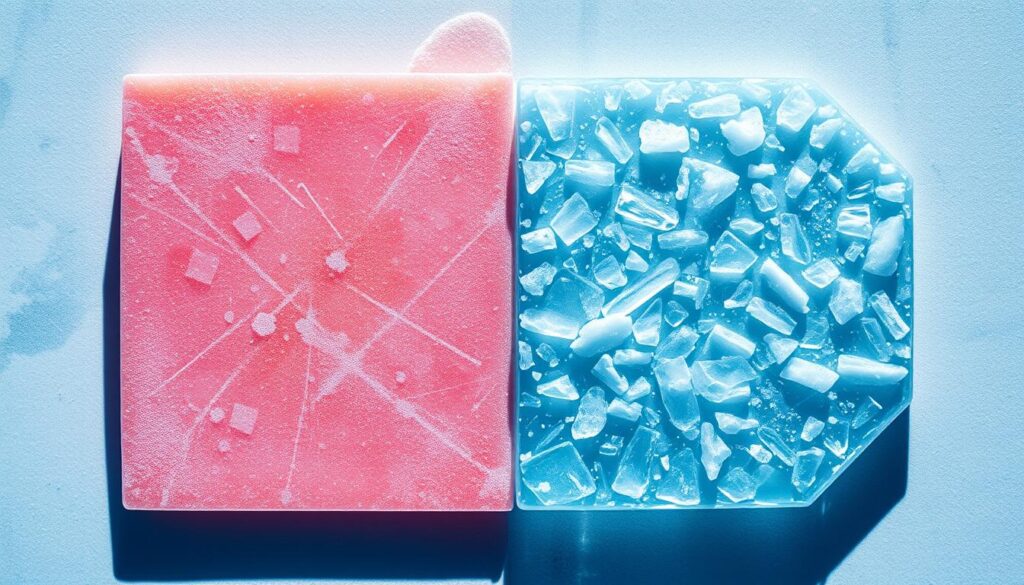
Looking at synthetic ice vs real ice, we find some key differences. These differences make each skating surface unique.
Friction Coefficients and Glide Quality
The main difference is in how easy it is to glide. Real ice lets you glide smoothly because it melts a bit. Synthetic ice takes a bit more effort to keep moving.
- Synthetic ice friction coefficient: About 8-10% higher than real ice
- Blades wear out a bit faster on synthetic surfaces
- But, with better making methods, glide quality gets better
Temperature Independence
Synthetic ice is great because it works well in many temperatures. Unlike real ice, which needs careful temperature control, synthetic ice stays steady.
| Surface Type | Temperature Range | Performance Consistency |
|---|---|---|
| Real Ice | 32-40°F (0-4°C) | Highly sensitive |
| Synthetic Ice | 20-100°F (-6-38°C) | Stable performance |
Maintenance Requirements
Keeping synthetic ice in good shape is different from caring for real ice. Synthetic ice needs less work but offers steady skating.
- Just clean it with special cleaners
- Now and then, add some lubricant
- Save money on keeping the temperature right
Those who choose synthetic ice vs real ice will find special benefits for their skating. It all depends on what they need for their skating.
Benefits of Installing a Synthetic Ice Rink
Discovering the advantages of a synthetic ice rink can change your skating experience. These surfaces are flexible for all skill levels. They offer unique chances that traditional ice rinks can’t.
Benefits of synthetic ice go beyond just being convenient. Skaters can skate all year, without worrying about weather or location. Whether you’re a pro or just skate for fun, you get to practice consistently.
- Year-round skating availability
- Lower maintenance costs
- Portable and easy to install
- Safe training environment
- Excellent for skill development
Both homes and businesses love synthetic ice rinks for their flexibility. Families can have a dedicated space at home. Athletes can work on their skills without needing to travel.
Cost savings are a big plus. Synthetic ice means no need for expensive cooling systems. This cuts down on ongoing costs, saving you money while keeping the ice quality high.
Professional skaters and coaches see synthetic ice as a top-notch training tool. It works for all skill levels and settings.
- Minimal setup requirements
- Compact storage options
- Durable construction
- Consistent performance
Thinking about setting up a home rink or a commercial facility? Synthetic ice rinks are a great choice. They offer flexibility, affordability, and top-notch performance.
Cost Analysis: Traditional Ice vs Synthetic Solutions
Skating fans and business owners often think about the money needed for a synthetic ice rink. Knowing the costs helps you choose wisely, balancing what you want and what you can afford.
Initial Investment Breakdown
The cost of synthetic ice varies a lot, based on your needs. A small home rink might cost $2,500 to $15,000. But, a big commercial rink could be $20,000 to $100,000.
- Residential synthetic ice rink: Smaller footprint, lower initial costs
- Commercial synthetic ice rink: Larger area, higher investment
- Modular panel systems: Flexible pricing options
Long-term Operational Expenses
Traditional ice rinks need a lot of power, cooling, and upkeep. Synthetic ice saves money on these costs. It’s a cost-effective alternative for skating lovers and training spots.
| Expense Category | Traditional Ice | Synthetic Ice |
|---|---|---|
| Monthly Electricity | $1,500 – $3,000 | $50 – $200 |
| Annual Maintenance | $5,000 – $10,000 | $500 – $1,500 |
Return on Investment Calculations
Buying a synthetic ice rink can save a lot of money over time. The upfront cost is usually paid back in 2-3 years. This is because of lower running costs and little upkeep.
- Calculate installation costs
- Estimate annual maintenance savings
- Project possible income
Wise investors see synthetic ice rinks as a good financial choice. They work well for both personal and business use.
Professional Training on Synthetic Ice Surfaces
Professional athletes are changing how they train with synthetic ice surfaces. This method lets them practice all year, no matter where they are. It’s a big deal for athletes who want to keep improving.
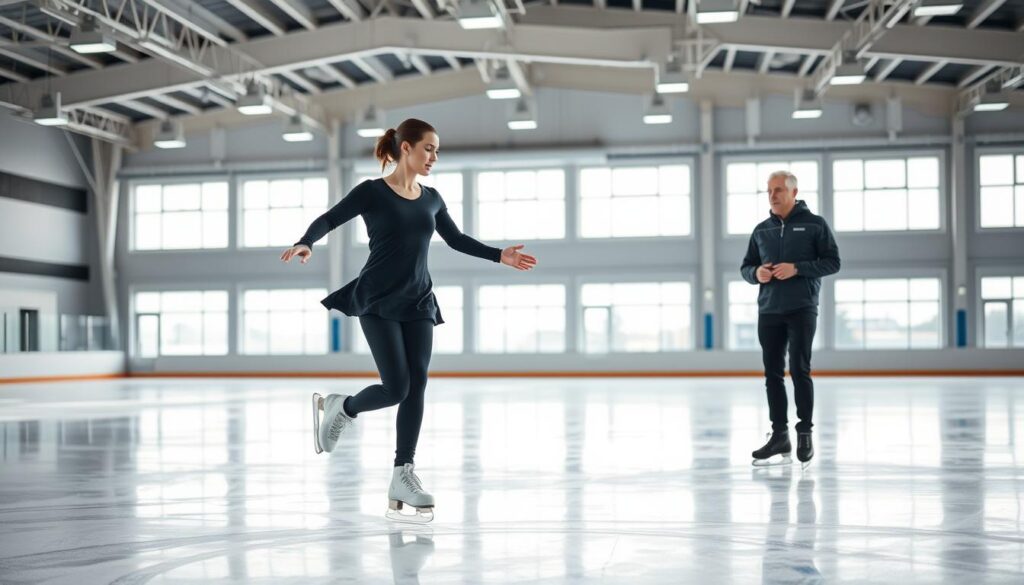
Top skaters and hockey players are finding big benefits in synthetic ice. It offers things that regular ice rinks can’t:
- Year-round training capabilities
- Reduced geographical limitations
- Cost-effective practice environments
- Customizable training spaces
Coaches see synthetic ice as a top tool for improving skills. Skaters can work on tough moves with just a few pieces of gear. The surface feels like real ice, helping them get better.
Here are some key ways to train on synthetic ice:
- Focusing on precise footwork
- Developing stronger leg muscles
- Enhancing balance and control
- Practicing complex movement patterns
Olympic figure skaters and pro hockey players are using synthetic ice more. The technology keeps getting better, making it even more like real ice.
Installation Guide for Synthetic Ice Panels
Turning your space into a skating paradise starts with knowing how to install synthetic ice panels. Whether you love hockey or figure skating, setting up synthetic ice needs careful planning and precise steps.
Before you start, there are key steps to prepare for your synthetic ice installation. These steps can greatly affect how well your skating surface performs and lasts.
Site Preparation Requirements
Getting your site ready for synthetic ice installation is the first step. Your area must meet certain criteria for the best results:
- A perfectly level surface with no big variations
- A clean, dry area without any debris
- A strong subfloor that can handle the panel’s weight
- Enough room for the activities you plan to do on it
Assembly Techniques
Installing synthetic ice panels needs precision and the right methods. Experts suggest these important techniques:
- Measure your space carefully before buying panels
- Make sure panels have interlocking parts
- Use the right adhesives or connection systems
- Make the skating surface smooth and seamless
Maintenance Protocols
Keeping your synthetic ice in good shape is key to protecting your investment. Proper care can help you save on costs:
- Clean it regularly with special synthetic ice cleaners
- Check the panels for wear and damage often
- Use tools made for synthetic ice surfaces
- Keep the temperature and humidity levels consistent
Pro tip: Synthetic ice panels need different care than traditional ice rinks. Spend time learning how to take care of them to get the most out of your investment.
Environmental Impact of Synthetic Ice Rinks
Skating fans are now thinking about the sport’s environmental impact. Synthetic ice rinks offer a new way for eco-friendly athletes to reduce their footprint.
Traditional ice rinks use a lot of energy to stay cold. Synthetic ice rinks are a big change for the better. They use less energy and give a great skating experience.
- Eliminates continuous refrigeration requirements
- Reduces water consumption by 100%
- Minimizes chemical treatment needs
- Provides longer-lasting surface materials
Synthetic ice is more than just good for skating. It shows a big commitment to the planet. Now, makers work on making materials that can be recycled.
| Environmental Factor | Traditional Ice Rink | Synthetic Ice Rink |
|---|---|---|
| Energy Consumption | High (Continuous Cooling) | Minimal |
| Water Usage | Frequent Resurfacing | None |
| Chemical Treatments | Regular Maintenance | Rare |
Now, skaters can enjoy their sport in a way that’s good for the planet. Synthetic ice rinks are a great mix of fun and being green. They show that new ideas can help the environment.
Selecting the Right Synthetic Ice for Your Needs
Choosing the right synthetic ice can change your skating experience a lot. Whether you skate at home or professionally, knowing the differences between synthetic ice rinks is key.

Different synthetic ice surfaces meet different needs. Your choice depends on important factors like performance, durability, and how it feels to skate.
Residential Applications: Creating Your Personal Skating Zone
Home skaters have exciting options with synthetic ice. Consider these:
- Panel size and setup
- How much space you have
- What you can spend
- How often you plan to use it
Commercial Solutions: Scalable Skating Environments
Commercial synthetic ice rinks need to be tough for lots of people. Look for:
- Strong materials
- Smooth skating
- Easy upkeep
- Custom options
Professional Training Facilities: Precision Matters
Top athletes need ice that feels like real ice. They look for:
| Feature | Professional Requirements |
|---|---|
| Surface Texture | Ultra-smooth, minimal resistance |
| Thickness | 10-12mm for optimal performance |
| Wear Resistance | High-grade polymer construction |
Pro tip: Always request product samples and performance demonstrations before final synthetic ice surface selection.
Essential Maintenance Tips for Synthetic Ice
To keep your synthetic ice surface in top shape, you need to take good care of it. A well-kept synthetic ice rink can last for years, giving you smooth skating every time. It’s great for both hobbyists and pros.
There are key steps to maintain your synthetic ice surface. These steps help keep your investment safe and your skating experience top-notch:
- Regular cleaning with specialized synthetic ice cleaning solutions
- Protecting the surface from direct sunlight and extreme temperatures
- Implementing routine inspection protocols
- Managing surface wear in high-traffic areas
Cleaning your synthetic ice rink needs special care. Don’t use harsh chemicals that can harm it. Instead, use cleaners made just for synthetic ice. Soft microfiber mops and gentle cleaners are best for keeping it clean and smooth.
Keeping the right temperature is also important. Synthetic ice can handle more than regular ice, but extreme temperatures can affect it. Store it indoors or cover it up when you’re not using it.
Here are some tips to make your synthetic ice last longer:
- Do daily cleaning
- Look for scratches or wear
- Switch up the high-traffic areas
- Store it right when not in use
Professional tip: Always follow the manufacturer’s specific maintenance guidelines for your unique synthetic ice surface to ensure optimal performance and longevity.
Adapting Skating Techniques for Synthetic Surfaces
Switching to synthetic ice needs some skill tweaks. Your skating might feel different, but you can get the hang of it fast. Just follow the right steps.
Synthetic ice brings its own set of challenges. You’ll need to make small changes to your skating. It’s all about how your blades interact with the surface, unlike regular ice.
Basic Skills Modification
Here are the key technique changes for synthetic ice:
- Apply slightly more pressure during glides
- Maintain a more upright skating posture
- Expect marginally increased resistance
- Use shorter, more controlled stride lengths
Advanced Maneuvers
For pros, here are advanced techniques for synthetic ice:
- Adjust edge work with slightly firmer blade contact
- Modify jump takeoff angles for consistent landings
- Practice power generation with more deliberate movements
- Focus on precise weight distribution
Pro tip: Regular practice helps develop muscle memory specific to synthetic ice surfaces.
Synthetic ice training is a great alternative to traditional rinks. It lets athletes and fans improve their skills in different settings. By adapting to synthetic ice, skaters can keep or even boost their performance.
Commercial Applications and Business Opportunities
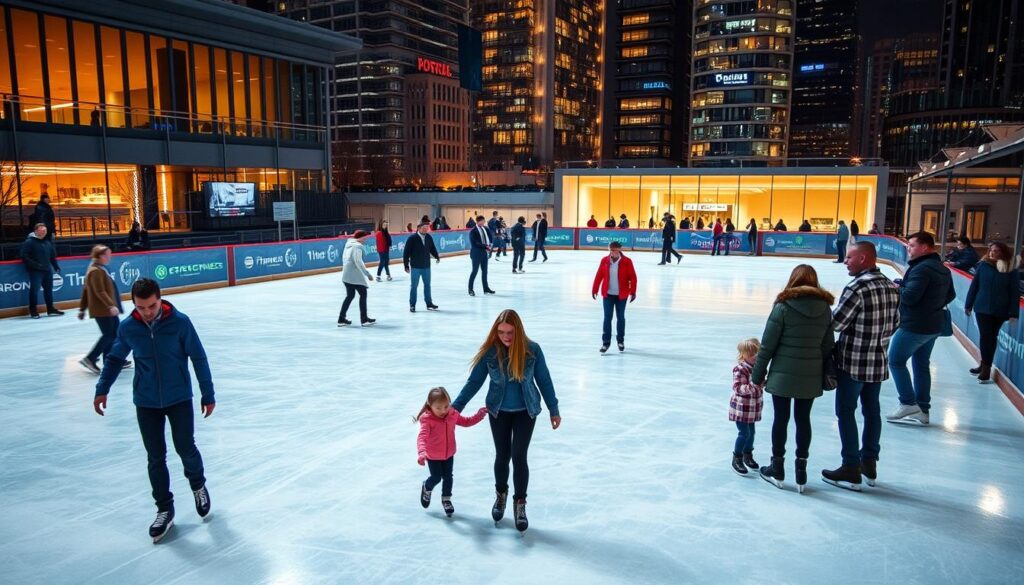
Entrepreneurs are finding new chances in the synthetic ice rink market. Synthetic ice rental services are versatile, opening doors in many sectors. They change how businesses handle ice activities.
Key business models for synthetic ice ventures include:
- Year-round training centers for athletes
- Event rental services for corporate and private functions
- Mobile synthetic ice rink experiences
- Entertainment venues for family recreation
Starting a synthetic ice rink business needs careful planning. The cost to start varies based on your operation’s size. Portable synthetic ice rental services are often more profitable, with less overhead than permanent setups.
Critical success factors for synthetic ice rental businesses include:
- High-quality surface materials
- Strategic marketing approaches
- Exceptional customer service
- Competitive pricing strategies
Potential markets for synthetic ice rinks go beyond skating. Schools, fitness centers, malls, and community centers are great opportunities for entrepreneurs.
Starting a synthetic ice rink business is appealing due to low startup costs and high revenue. These solutions are easy to maintain and can be used all year. They offer a strong business model for investors.
Safety Considerations for Synthetic Ice Skating
Skating on synthetic ice needs careful safety steps. It’s important for both new and experienced skaters. Knowing the key safety tips can help avoid injuries and make your skating fun.
Proper Equipment Usage
Choosing the right gear is key for safe skating. Your equipment helps protect you from accidents.
- Wear properly fitted skates with sharp blades
- Use protective padding for knees and elbows
- Always wear a helmet, even if you’re experienced
- Choose skates made for synthetic ice
Risk Management Strategies
Reducing risks on synthetic ice involves planning and being aware. Good risk management can lower accident chances.
- Check the synthetic ice before skating
- Make sure the area is clear of obstacles
- Set up clear skating zones
- Supervise kids properly
Emergency Protocols
Being ready is essential for synthetic ice skating safety. Create detailed emergency plans to handle incidents fast and well.
- Keep a first aid kit nearby
- Post emergency contact info
- Train staff in basic first aid
- Have a clear evacuation plan
Always put safety first when enjoying synthetic ice skating.
Latest Innovations in Synthetic Ice Technology
The world of synthetic ice technology is changing fast. New developments are making artificial ice surfaces better for athletes and fun for skaters. Scientists and makers are working hard to make synthetic ice feel and act like real ice.
Recent breakthroughs in synthetic ice technology have focused on several key areas:
- Advanced polymer compositions
- Enhanced glide performance
- Performance tracking capabilities
- Sustainable manufacturing processes
New synthetic ice surfaces are being made with amazing features. Molecular-level engineering has made them smoother and better for skates. Now, even pro athletes say synthetic ice feels almost like the real thing.
| Innovation Area | Key Technological Advancement | Performance Impact |
|---|---|---|
| Material Science | Self-lubricating polymers | 40% reduced friction |
| Smart Surface Technology | Embedded performance sensors | Real-time skill tracking |
| Sustainability | Recyclable synthetic materials | Eco-friendly production |
The future of synthetic ice technology is bright. Skaters can look forward to even better surfaces, tracking, and being kind to the planet. As research keeps going, the difference between real and synthetic ice will keep getting smaller.
Conclusion
Our look into synthetic ice skating shows a world that’s changing how we skate. It’s not just a different surface; it’s a flexible option that goes beyond ice. It lets everyone, from backyard skaters to pros, enjoy skating all year.
The tech behind synthetic ice keeps getting better. Now, skaters can enjoy a more real skating feel. It’s great for learning or for those who want to skate all year, without weather worries.
Getting a synthetic ice rink is more than buying something. It opens up new skating chances. It’s affordable, easy to keep up, and fits many needs. As tech grows, so will the quality of synthetic ice.
Your skating adventure is just starting. Try new things and dive into the world of synthetic ice skating. The rink is ready, and your next adventure is close.
FAQ
What exactly is synthetic ice?
How does synthetic ice compare to real ice in terms of performance?
Can I use regular ice skates on synthetic ice?
What are the primary benefits of installing a synthetic ice rink?
How much does a synthetic ice installation typically cost?
FAQ
What exactly is synthetic ice?
Synthetic ice is a man-made skating surface made from special polymer panels. It’s designed to feel like real ice. Skaters can use standard ice skates and move like on real ice, making it great for year-round skating.
How does synthetic ice compare to real ice in terms of performance?
Synthetic ice has a bit more friction than real ice, but modern tech has made it close. Today’s top synthetic ice panels offer 90-95% of real ice’s glide. Skaters might need to push a bit harder, but it’s very similar.
Can I use regular ice skates on synthetic ice?
Yes, you can use regular ice skates on synthetic ice. But, it’s better to use slightly sharper blades. This way, you’ll get more wear on your skates. Some skaters even have a special pair for synthetic ice.
What are the primary benefits of installing a synthetic ice rink?
Synthetic ice has many benefits. It lets you skate all year, no matter the weather. It’s also cheaper to maintain and doesn’t need special temperatures or humidity. Plus, it’s easy to set up in different places and is good for the environment. It also provides a consistent training surface for athletes.
How much does a synthetic ice installation typically cost?
The cost varies a lot. For a home, it can be – per square foot. A typical home setup might cost
FAQ
What exactly is synthetic ice?
Synthetic ice is a man-made skating surface made from special polymer panels. It’s designed to feel like real ice. Skaters can use standard ice skates and move like on real ice, making it great for year-round skating.
How does synthetic ice compare to real ice in terms of performance?
Synthetic ice has a bit more friction than real ice, but modern tech has made it close. Today’s top synthetic ice panels offer 90-95% of real ice’s glide. Skaters might need to push a bit harder, but it’s very similar.
Can I use regular ice skates on synthetic ice?
Yes, you can use regular ice skates on synthetic ice. But, it’s better to use slightly sharper blades. This way, you’ll get more wear on your skates. Some skaters even have a special pair for synthetic ice.
What are the primary benefits of installing a synthetic ice rink?
Synthetic ice has many benefits. It lets you skate all year, no matter the weather. It’s also cheaper to maintain and doesn’t need special temperatures or humidity. Plus, it’s easy to set up in different places and is good for the environment. It also provides a consistent training surface for athletes.
How much does a synthetic ice installation typically cost?
The cost varies a lot. For a home, it can be $3-$15 per square foot. A typical home setup might cost $1,500-$5,000. For bigger spaces or commercial setups, it can go up to $50,000-$100,000.
How do I maintain synthetic ice panels?
To keep synthetic ice panels in good shape, clean them regularly with special cleaners. Avoid harsh chemicals and use soft cloths or mops. Rotate and flip the panels to wear them evenly. Clean your skates before skating and don’t drag heavy things on the ice. With proper care, high-quality panels can last a long time.
Is synthetic ice suitable for professional training?
Yes, it’s perfect for professional training! Many athletes, including figure skaters and hockey players, use it for off-season training. It’s a reliable surface that closely mimics real ice, making it great for serious athletes.
,500-,000. For bigger spaces or commercial setups, it can go up to ,000-0,000.
How do I maintain synthetic ice panels?
To keep synthetic ice panels in good shape, clean them regularly with special cleaners. Avoid harsh chemicals and use soft cloths or mops. Rotate and flip the panels to wear them evenly. Clean your skates before skating and don’t drag heavy things on the ice. With proper care, high-quality panels can last a long time.
Is synthetic ice suitable for professional training?
Yes, it’s perfect for professional training! Many athletes, including figure skaters and hockey players, use it for off-season training. It’s a reliable surface that closely mimics real ice, making it great for serious athletes.
